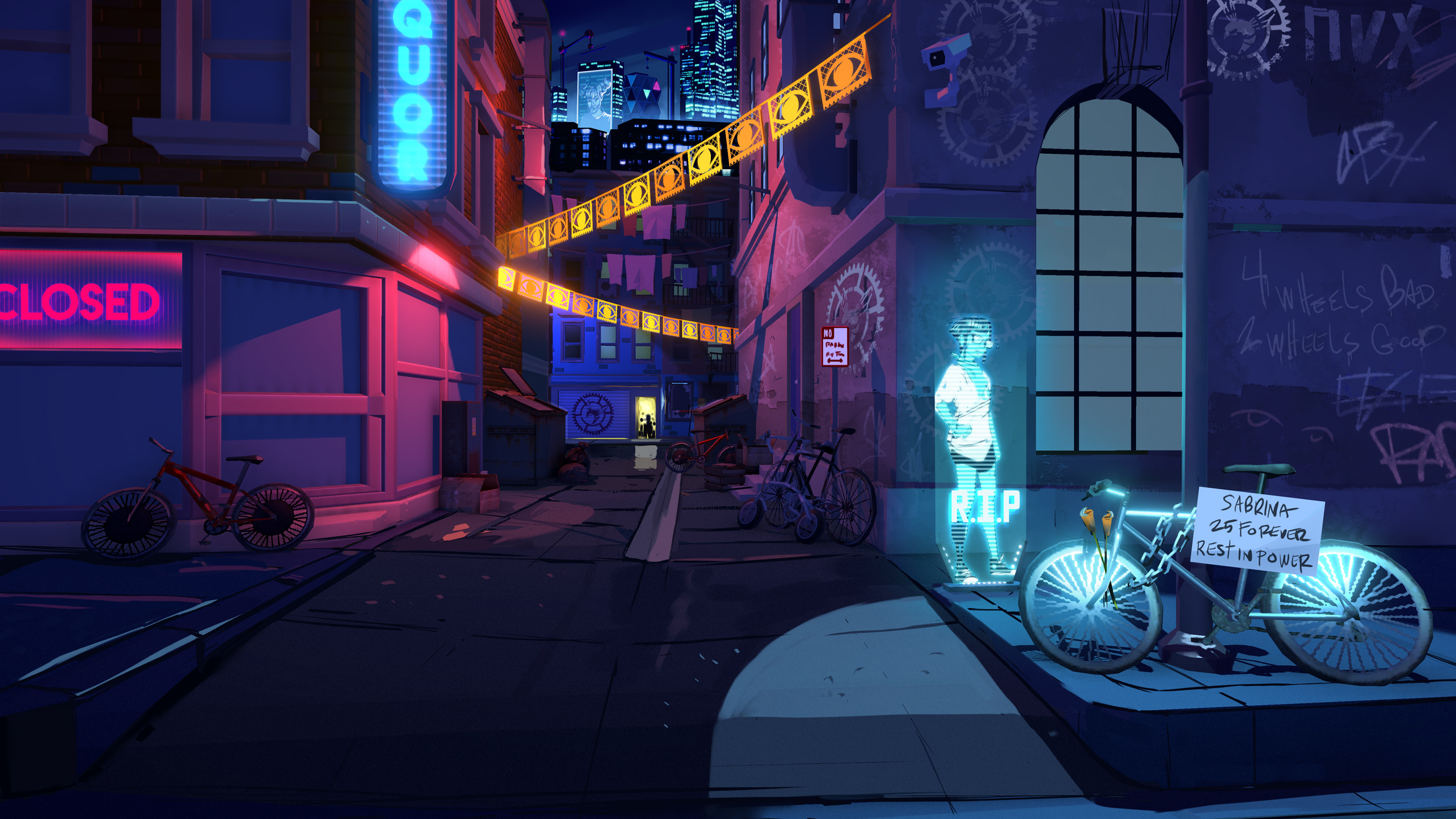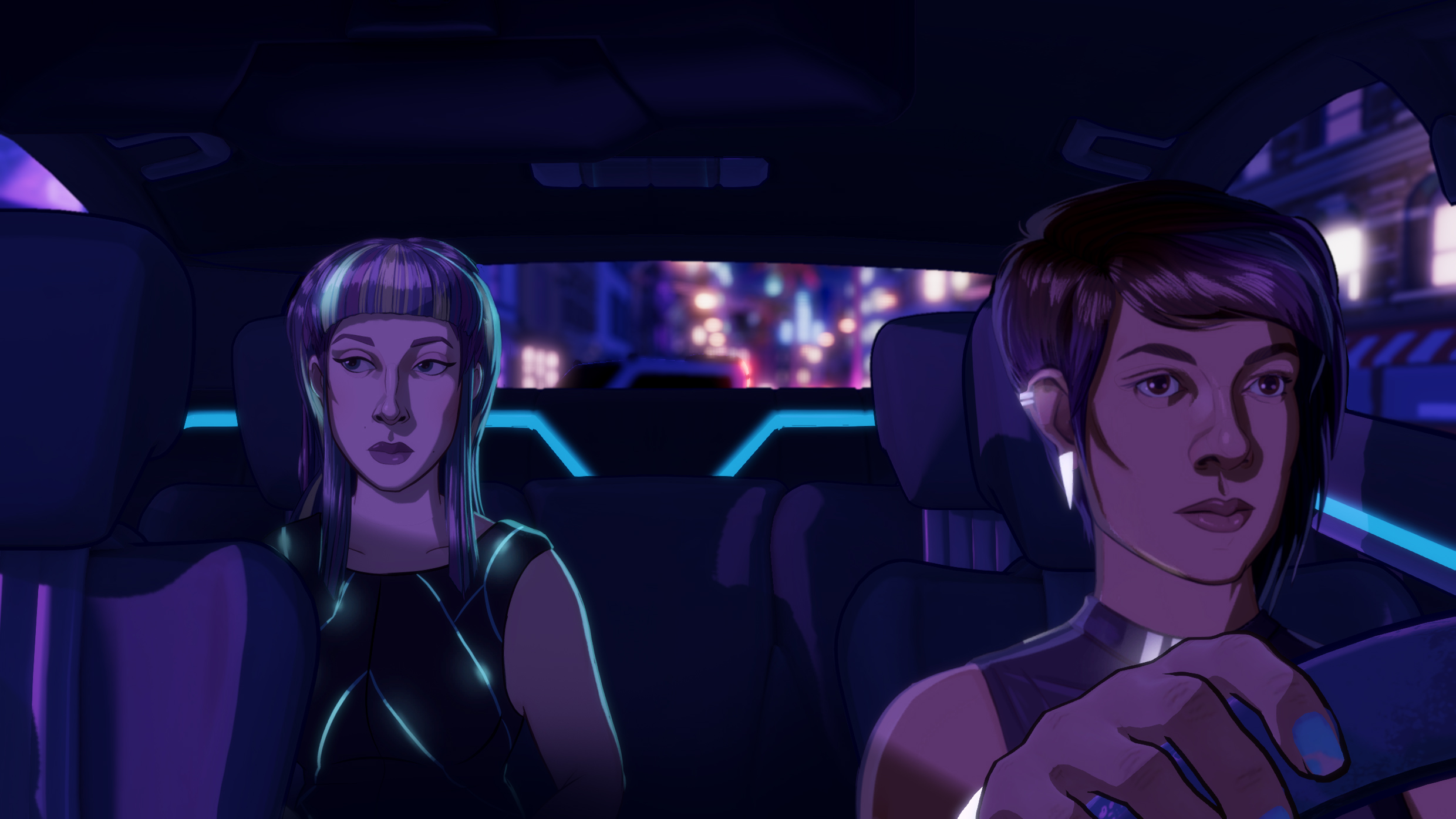How the creators of Neo Cab want to make emotion 'truly matter to gameplay'
Chance Agency explains how emotions affect your performance on the job.
Being nice has a price in Neo Cab, a job sim and interactive fiction game set in the near-future tech dystopia of Los Ojos, which was shown at the PC Gaming Show at E3 today.
AI has taken over huge segments of society, including transportation, where self-driving cars have almost entirely replaced human drivers. Lina is one of the last of her kind, a human driving other humans for a fare. She has to make enough money while driving to get by without running herself ragged and always keeping her customer star rating stellar. Neo Cab is a deeply branching narrative from Chance Agency in which choices matter not just to the overarching plot, but to Lina and every passenger she interacts with. The team at Chance Agency spent an hour explaining how Neo Cab’s interactions work and why emotions are so central to the game.
PC Gamer: What does gameplay look like minute to minute in Neo Cab?
Patrick Ewing: It’s definitely in a category with Papers, Please. You’re always doing a job while the narrative is uncovering itself. In both cases, the biggest stakes in the game come from your job. In Papers, Please this is a job you need to have because you’re working in an oppressive state. In Neo Cab you’re one of the proletariat who are just riding the line of capitalism. [Lina] is fine on any given day as long as something really bad doesn’t happen or a few bad things happen in a row. That’s something we drew from real gig drives where if their rating drops below a 4.7 they will get “termed.”
We started from there and said “OK, Lina is precariously positioned. She’s in the city. Her only friend and lifeline here has vanished. She needs to make money to survive and she needs to keep her rating high to avoid getting fired. So that gameplay really does matter, ride to ride. After every ride experience you return to a map and you have a choice from a minimum of three passengers to pick up. We borrowed the tone of the Twitter profile. How do people choose to sum up themselves in a compressed way? You’re trying to guess: is this person interesting? Is this person dangerous? Are they going to give me a low rating?
Within the ride, you’re trying to figure them out such that they give you a good rating while also balancing your emotional health which persists. That’s the core narrative tension that we think no one’s really done before in an interactive game: a fine grain modeling of the emotions of the player character and having that impact core gameplay stuff. So, [it affects] what choices you’re able to make. When does your character not give you a choice at all? When is she really mad and fly off the handle and kick someone out of the car? When she’s really sad, when does she say “I can’t keep driving tonight. I know I need the money but I’m going to sleep in my car.” We spent a lot of work exploring how to bring that in every line of the narrative. It’s feeling really exciting to us!
You’re balancing your own emotional health which is sometimes in tension with the needs of your passengers. So gameplay is mostly dialogue choices and your choice of passengers?
Keep up to date with the most important stories and the best deals, as picked by the PC Gamer team.
PE: Yup, and then on the map there’s some other choices. Physically, what are the things you can do to recharge yourself emotionally like spending some money on a nice hotel instead of sleeping in your car or visiting a street doctor and getting an herbal supplement that can maybe boost you up but are there risks to that? Emotional realism, I guess you could call it? We’re trying to express the fact that the way you feel can be as important as how much money is in the bank, especially for someone in the service industry.
Given that cab rides are typically a low consequence interaction, how are you getting stories out of characters either as Lina or as a writer?
PE: One weird thing we weren’t expecting when we set out on this and weirdly ended up being a lot of artistic license for us: since we’re in the near future when autonomous vehicles have really taken over and everyone’s just taking little robot rides everywhere we asked ourselves, “Why do people still take these cabs?” It’s because they need the human element. Either they’re someone who doesn’t have an identity or they’re illegally here and they can’t be in a database somewhere or maybe they need a human. They don’t have anyone and they need someone to talk to. It actually kind of lends itself really well to more dramatic situations and not just like, “Ah, I’m trying to get to work.” We ask that with every character we come up with. We say: “Why is this person specifically taking a Neo Cab in the middle of the night? What’s their reason?”
Patrick you mentioned in a blog post your time on Firewatch and people’s reactions to the game being very personal. Neo Cab you say is less about a character who players empathize with and more about a character whose strength is empathy. How does that distinction change how you want players to react to Neo Cab?
PE: Games have something of a bad name now because a lot of people have tried things that turned out to be pretty clumsy. Firewatch works because you go really really deep on these two characters’ lives. From the vignettes in the beginning to day one or day two you’re really learned where Henry’s been, his regrets, his pain. You start to learn the same thing about Delilah.
The big part for me from the beginning here was each one of these stories, you need to have the choice to go deep with each character. You don’t have to. You can have a ride with somebody and decide you don’t like that person and you don’t have to hang out with them anymore. For the people you are drawn to, and we have a diverse writing staff for this reason, you can go deep with them. People you see in a lot of noir films and noir fiction especially, these people are hurting. They’re imperfect people. They have regrets. They have some sort of struggle they’re going through right now and they need help.
Lina is this unique character who has an incredible ability to read people and a real in-grown kindness that she wants to help people. It was sort of a bet on people liking helping other people. It’s not something you get to do a lot in videogames. It requires cleverness. That’s why the emotional balancing system is so important because it’s not just like, “Oh, I’m going to be nice all the time and people will love me. Yay!” It’s got to be honest and it’s got to be balancing the player characters needs with her innate kindness and her empathy for players.
Do you have any examples you’re able to share of a character or interaction that showcases that choice between Lina’s own emotions versus a passenger’s emotions?
Paula Rogers: We have this character who I think pretty objectively looks a little scary and a little intimidating when you see his small picture and his profile and he has a cryptic message about “the pain worm.” He’s this very morose, intimidating character with this cranial tattoo and he has this dead-eyed stare and he’s very somber and dressed in black. Being nice to him actually angers him. He presents as very morose and you have to learn that’s what he wants. It’s not a one size fits all. You can’t just be nice and friendly to everyone.
You really have to intuit based on emotional cues or if your [passenger] starts talking about “the pain worm” then you can kind of get “Oh, OK, he might be more wanting a different kind of connection.” Not a platitude or friendliness but someone to echo or recognize his pain or his sadness and as you learn more about this character you realize he belongs to this kind of religion that—I wouldn’t say fetishizes sadness—but definitely seeks that out. There’s an authenticity to pain that’s being lost in this world where everything is about comfort and convenience. That’s kind of a revolutionary way to live your life. If you commiserate with him you actually make him…”Happy”?
How are the emotions of Lina and her passengers communicated to the player? Dialogue? Interface?
Vincent Perea: The thing we didn’t want to do is make a game where you have a health meter or “sad meter”. With emotional well-being it’s a bit more complicated than that and we didn’t want to do it the disservice of having it be a meter.
PE: So, the core sci-fi conceit (and also a primary UI element) in our game is the Feelgrid—a consumer biometric device people wear in one form or another as jewelry (bracelets, necklaces, earrings, skin patches etc.) which reads your up-to-the-nanosecond emotional response and, in most cases, mirrors it back out as a color gradient... like a FitBit for feelings. In the world of Neo Cab, Lina relies on her Feelgrid and many of her [passengers] wear them, too.
Every time Lina's "affect" (the physiological base that all emotions are built on— essentially, the way you feel inside your body when you're anxious, chill, depressed, aroused, overjoyed, etc) changes, players see her Feelgrid buzz, flare up and change color. This color is something we invented on top of the "circumplex model of emotions" which scientists use to measure these things. We just map every part of the emotional space to a color, to make it easy to read: It helps that human language already maps emotions to colors! Feeling blue, seeing red, a sunny personality, etc. We've playtested this a lot and are stoked that people immediately get this system— and then our character's facial expressions are driven by the same underlying variables, so that reinforces the vibe further.
We invented all this because we found two main problems with previous attempts to make emotions truly matter to gameplay: either the systems were too simple to feel true to the nuances of human emotion, or they were too complex be legible in the game's interface. In the first case, you risk having one-dimensional characters who shift mechanistically from trigger to trigger. On the other, you have an inscrutable, almost manic-depressive character whose emotions shift in ways you can't understand or predict. We feel like the Feelgrid is a sweet spot—it's complex enough to map to a broad range of human emotion, with all of the subtle gray areas between, eg, "tired" and "depressed" or "anxious" and "angry"—but it's simple enough that players can see the whole system at a glance—no hidden variables or compound stats.
PR: We also branched the dialogue choices based on what color she is in the Feelgrid. So you’ll learn too that if you are in this red angry state and someone says something obnoxious to you, you’ll see a choice to just shrug it off but if you’re too far in the red or too agitated that choice will be disabled. When you click it, you’ll see that it’s because you’re too far in the red.
So it will show you options that are disabled?
VP: Yeah, we’ve actually been working really hard so that they don’t look like things that are disabled. We want people to engage with them because it will let them know where she’s at as well. We didn’t want it to segment Lina in a binary way. The Mass Effect example is that they’re not “paragon” and “renegade” options. It doesn’t kick her to a different personality. In the moment this is a thing she’s emotionally unable to say. It makes for some interesting rides because sometimes if you’re on a certain emotional journey and you need that emotion that’s gated off to you it puts you in a tough spot. We’ve all been there are the end of a really long day. You need to maybe share some patience or compassion and you are just not capable of it.
Neo Cab doesn't have a release date yet, but you can follow along with development on the official site.

Lauren has been writing for PC Gamer since she went hunting for the cryptid Dark Souls fashion police in 2017. She joined the PCG staff in 2021, now serving as self-appointed chief cozy games and farmlife sim enjoyer. Her career originally began in game development and she remains fascinated by how games tick in the modding and speedrunning scenes. She likes long fantasy books, longer RPGs, can't stop playing co-op survival crafting games, and has spent a number of hours she refuses to count building houses in The Sims games for over 20 years.



